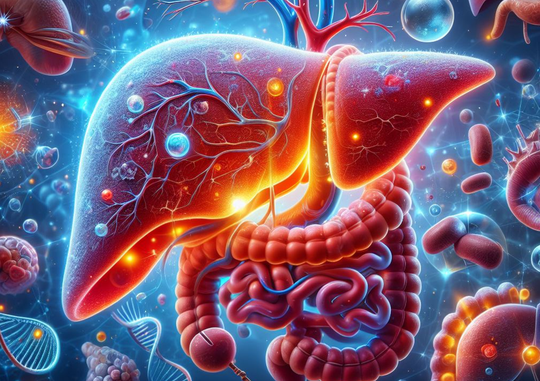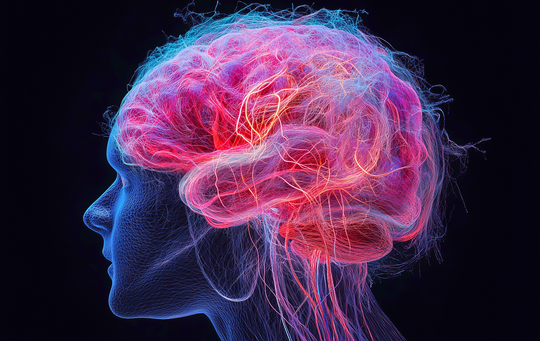Today I'll talk about red light vs blue light therapy. Both therapies have become really popular in the last few years, especially the red version. But lately, companies have also integrated blue light into some red light therapy products.
I'll consider the differences between red light vs blue light, their benefits, examples of how to use them for skin health, your eyes, sleep, and teeth whitening.
Blue light therapy emits wavelengths between 400-500 nm and only targets superficial skin layers, effectively treating acne, improving the skin microbiome, and boosting alertness by influencing circadian rhythms. Blue light is particularly beneficial for acne due to its antibacterial properties. Red light therapy, however, supports deeper tissue healing and has greater anti-aging effects.
Let's go:
Blue Light vs. Red Light Wavelengths: What's the Difference?
In this section, I'll talk aboutt he blue light vs red light wavelengths differences. Blue light and red light have very different effects. But, red light and blue light can also be separated by a strict definition in physics - wavelengths (1; 2; 3; 4).
Let's explore that concept:
What Is The Wavelength Of Red Light?
Many people ask: "What is the wavelength of red light?" Red light has a wavelength of about 600 nanometers (nm) to 700-740 nm. Definitions of where red light exactly ends and where infrared light starts don't all agree.
So, generally, the red wavelengths in nm range from 600 - 740nm.
What Is The Wavelength Of Blue Light?
Next up the question "what is the wavelength of blue light?"
The answer:
Blue wavelengths range from 400-500nm, although blue can be subdivided - I'll arrive at that topic soon. The concepts of "blue light frequency" and "blue light wavelength" are intertwined - it's easier to talk about wavelength as more people are familiar with that concept.
Within the "visible light spectrum" - colors of light visible to the naked eye - the blue and red are located at completely opposite ends. Here you can see that visible light spectrum:

As you can see, the defintions of the blue and red wavelengths are slightly different. But, you can see all colors of the rainbow there.
What's important to understand here is that both wavelengths of blue light and red light interact with the human body. Blue light mostly affects the superficial skin tissues while red light penetrates into your body and has many different effects there.
Let's consider what benefits those interactions of light with your body's biology have:
Blue And Red Light Therapy Benefits
So let's explore some basic blue and red light therapy benefits. I'll keep these benefits short though so that you'll keep an easy overview.
First up, blue light therapy benefits:
- Blue light can improve skin health and affect many skin conditions such as acne and rosacea (5; 6; 7; 8; 9). Blue light can improve the microbiome in the skin, for instance. And blue light is used in many cosmetic light therapy products for this very reason.
- Blue light makes you feel more awake (10; 11; 12; 13; 14; 15; 16). Simply put, your ancestors were exposed to blue light from the sun in the morning, historically. And at night, campfires and moonlight exposed them to almost no blue light at all. Right now, blue light exposure from smartphones and artificial lighting still wakes people up no matter the time of the day. So use blue light exposure strategically during the morning and afternoon--not at night.
- Blue light may counter depression and make you feel better (17; 18; 19; 20; 21). The research on this topic is a bit controversial, but especially for "Seasonal Affective Disorder" (SAD), blue wavelengths counter depression. For regular depression the jury is still out.
Next up, red light therapy benefits - which are almost uncountable:
- Quicker athletic recovery and better performance (22; 23; 24; 25; 26; 27). Almost across the board, in both athletes and people with health conditions such as arthritis, red light improves recovery and enhances both endurance performance as well as strength and power.
- Impedes chronic and acute pain (28; 29; 30; 31; 32; 33; 34; 35). Whether you're talking about musculoskeletal pain, joint pain, dental pain, or neuropathic pain, red light therapy often makes a huge difference in these areas.
- Improves skin health and wound healing (36; 37; 38; 39; 40; 41). The effects of red light therapy on collagen and elastin, resulting in better skin tone, are unsurpassed. People notice real differences, especially over the course of consistent treatments of several weeks.
- Aids hair regrowth and health (42; 43; 44; 45; 47; 48). Most studies on this topic are really positive, especially if the hair loss hasn't become too problematic yet. Early treatment works best, but not in every case, as red light therapy won't help you deal with stress-related hair loss or because of poor nutrition, for instance. In people with healthy hair, red light therapy may also increase hair count and thickness.
- Many other red light therapy benefits exist that I won't go into here. Examples are benefits for blood circulation, orthodontics, lymphoedema, PTSD, depression, Alzheimer's and dementia in general, neurological conditions, some substance abuse disorders, brain injuries, eye health, reduce inflammation, and more. Hopefully, you understand you get the idea though!
So, the blue and red light therapy benefits are fundamentally different. These benefits do stack, though, so you can combine them if you have a device that emits both blue and red wavelengths.
What Wavelength Of Blue Light Is Best?
So here I'm talking about the red light vs blue light frequency, or "wavelength". There isn't an easy answer here as all wavelengths have potential benefits. So let's explore different blue light wavelength effects.
- Blue light (400-500nm wavelength) has the benefits I described above, such as improving skin health, potentially countering depression (especially SAD), and making you feel more awake.
- Purple light (400-430nm wavelength) improves blood flow and may counter acne (49; 50).
- Cyan light (470-500nm wavelength) has benefits such as in wound healing, making you more motivated through dopamine stimulation in the eye, countering acne, and potentially aiding bone health (51; 52; 53; 54).
So no blue light wavelength is superior - they all have different effects. Also, a lot more research needs to be carried out on the exact differences between purple, blue, and cyan.
(Technically cyan and purple are blue light, but just specific types of blue light).
Let's move on to another important question:
Blue Light Vs Red Light For Sleep
Next up, let's consider blue light vs red light for sleep. Red light is the clear winner here as it doesn't suppress melatonin levels in your brain (55; 56; 57; 58; 59).
The problem with blue light is, that when it enters your eyes, it tells your body it's daytime. The result is that you'll stay awake and sleep quality goes down. Ideally, you'll thus use blue light therapy during the morning and afternoon, but not at night because of sleep.
With red light therapy the link is more complicated. Check the video on red light therapy and sleep below for more information:
Red light therapy can support healthy sleep.
Some people can use red light therapy in the afternoon and night as well. But if red light therapy is overstimulating for you, it's best to plan your sessions during the daytime hours.
Full Spectrum VS Red/Blue Grow Lights?
Can you use grow lights for therapy? Yes. But is doing so optimal?
Let's find out:
First up, remember that so far, I'm talking about human use of red and blue light therapy here. I'm not talking about blue light vs red light for plants or even grow lights in general.
If you're interested to learn more, check out this video by Alex Fergus on why grow lights may not be optimal for human use:
Learn why a full spectrum vs red/blue grow light discussion is obsolete for human use. Grow lights are simply configured incorrectly in terms of wavelengths.
In essence, we don't care about plant growth. Grow lights are set up in such a way that they're not optimal for human use. So get a normal blue light therapy or red light therapy device instead!
Let's consider the topic of devices right now:
The Best Light Therapy Devices
Below I'll list a few great videos when considering different red light therapy devices. First up, the budget tabletop panels, which are great for treating smaller areas of the body:
In this video, Alex Fergus compares the best budget red light therapy panels and picks a winner.
Next up, if you've got a bigger budget, consider the premium tabletop panels:
If you want the best, these tabletop panels are amazing. The winner of this competition also includes blue light!
Lastly, bigger panels allow you to treat larger areas of the body. Usually, you need multiple of these panels for full-body treatment, however. But, check out the best bigger panels here:
These panels are big enough so that you can treat large areas of the body at the same time
And, if you want more information on the wavelengths of blue light, consider this video:
This video takes a deeper dive in not only the best wavelengths of blue light, but also the devices you may want to use
Now that you know about devices, let's check what works best: red light vs blue light for skin:
Red Light vs Blue Light for Skin: Which Works Better?
Simply put, there's no winner in this category. Both types of light have their own indepdendent effects. Let's explore these effects:
Blue Light Vs Red Light For Skin
Recall the studies I quoted earlier on the benefits of red vs blue light therapy. Red light has better results for lines and wrinkles because it affects collagen and elastin production in the skin. Red light is also great for blood flow and reducing redness in the skin.
Blue light, on the other hand, is superior for some skin conditions. Examples here are acne, psoriasis, and atopic dermatitis. But, as stated before, you can use red and blue light together for the best effects. So there's no need to choose.
Does Blue Light Therapy Help With Wrinkles?
Next up, "Does blue light therapy help with wrinkles?" The answer is "no" here, as there's currently no evidence that blue light therapy helps with wrinkles. The red light is superior in this case, helping elastin and collagen production in the skin. I.e., red light is ideal for fine lines and wrinkles.
For skin conditions, however, blue light is often superior. So in the case of the question of red light or blue light for acne, the latter wins out.
Red Or Blue Light For Rosacea?
Rosacea is an exception where red light is superior as a therapy compared to blue light (60; 61; 62; 63; 64; 65). The research isn't perfect here but it's promising. Anecdotally, improvements in this area are also huge. But, ideally we'll see more high-quality studies on this topic with human participants.
Does Blue LED Light Therapy Cause Hyperpigmentation?
In some instances, blue light can induce hyperpigmentation (66; 67). But, it also seems right now that an adequate nutritional intake, such as of vitamin B3 (niacin) protects against these effects.
And, hyperpigmentation is a complex phenomenon that has many influences beyond blue light exposure alone (68; 69; 70; 71). Pharmaceutical drugs and peels are the main course of current hyperpigmentation treatment.
Suffice it to say that you probably don't have any hyperpigmentation risk of blue LED light therapy with normal use.
Overexposure of blue light, however, is considered dangerous. But that overexposure is mainly a risk nowadays because people spend their nighttimes in front of screens and artificial light that emits lots of blue light, thereby impairing their night and day cycle.
Blue Light Vs Red Light For Face
Once again, there's no clear winner here. The blue light vs red light for face competition is thus won by neither option. Many companies intentionally treat the face with both options, in fact. I'll post two examples of these facial treatment options below:
The Omnilux Men's Mask is great for women too. Alex Fergus has tested this mask for five weeks in this video and talks about his surprising before and after results!
The Omnilux Men Mask is one of the most popular facial treatment masks out there. The mask doesn't use blue light, however, but is worth mentioning. The Dermalux Flex MD listed below does use blue light in addition to red and a bit of near infrared - check out the review:
The Dermalux Flex MD is one of the trendsetters in the facial care space. But is the price tag worth it? Find out in the video above!
So, in an ideal world, you don't choose in the blue light vs red light for face competition - you use both.
Red Light Vs. Blue Light For Eyes: Benefits And Safety Instructions
Red light vs blue light for eyes is a complex topic. Generally, red light is more beneficial here. Red light has a whole host of benefits for eye health, such as countering "Age-related Macular Degeneration" (AMD), improving retinal health, dry eyes, and more (72; 73; 74; 75; 76; 77; 78; 79; 80; 81).
Besides, red light therapy has tons of benefits for the brain and for circulation. Those benefits will indirectly aid eye health as well.
Nevertheless, eye health treatments are complex and can have side-effects if you're dosing incorrectly. For that reason, I always recommend following the instructions that come with the light therapy device that you've purchased.
Yes, the benefits of red light therapy for eye health are potentially huge. For instance, there's tons of evidence for red light therapy for AMD, but, you'll want a medical professional administering the light in that case. In some cases, high power outputs are needed for healing, making the risk of overdosing (and therefore side effects) even greater.
Next up, there's blue light. Excessive blue light exposure has been linked to eye hazards (82; 83; 84; 85; 86). It's mostly artificial light sources that are the culprit here, such as working in front of a screen all day, overhead fluorescent lighting or blue-dominant LED lighting, and nighttime exposure.
But, you'll have to be careful with blue light therapy devices as well. Wear protective eyewear when instructed to when you're exposing yourself to too much blue light.
And, the risk of blue light exposure goes up if 1) you're already exposed to lots of blue light during the day because you work in a blue-lit office or similar area; 2) you're exposing yourself to blue light at night. In both cases, be extra careful and protect yourself by wearing safety goggles.
Next up, how about sleep? Let's explore that topic:
Blue Light Or Red Light For Good Night Sleep?
Let's return to a topic which I've briefly covered before - that of blue light or red light for good night sleep. If you've checked the video I posted on red light therapy and sleep, you know that it's generally very supportive according to the few studies published on the topic.
However, the same is true for blue light when used appropriately. And, while a blue light therapy device may be decent, the best source of blue light exposure is almost certainly the old-fashioned sun.
Sunlight has tons of overall health benefits, such as helping create vitamin D in the skin, improving blood circulating, lowering autoimmune disease risk, countering inflammation, better mental health, lower overall disease and mortality risk, and much more (87; 88; 89; 90; 91; 92).
Many of these sunlight effects don't happen because of vitamin D but because of all the wavelengths reaching the earth. Not only do different types of ultraviolet and infrared reach your skin, you'll also get violet, blue, cyan, green, yellow, orange, and red light exposure. And, sunlight is the historical method through which people got exposed for all of history before we started moving indoors in the Industrial Revolution.
So, if you want to use blue light for sleep, use sensible sunlight exposure during the day. Avoid a sunburn by leaving the sun long before you get symptoms, or by covering up with clothes.
Another less useful method for blue light therapy for sleep is by using an SAD lamp. Both white light and blue light SAD lamps work well for this purpose, but make sure to use them in the morning to set your circadian rhythm. The circadian rhythm is the 24-7 clock located centrally inside your brain and peripherally all of your body's cells.
Next up, another important topic:
Teeth Whitening With Light Therapy
Blue light can be used for teeth whitening with light therapy (93; 94; 95; 96). More research is needed though but existing research is very promising. It's especially the violet light that is promising here, often paired together with other dental whitening treatments.
Blue light is an effective treatment here without side effects, when used properly. Also, red light therapy may be helpful for teeth whitening too, to counter potential side effects from these procedures (97; 98; 99). Most studies in this area are positive. The biggest problem here is that bleaching causes dental hypersensitivity, which is countered by the red light.
Overall, teeth whitening with light therapy has a very favorable profile, although more research is needed.
Conclusion: No Need To Choose From Red Light Vs Blue Light Therapy
Red light vs blue light therapy is a bit of a nonsensical discussion because you don't have to choose. You can use both options, which both have their own unique benefits.
Overall, there's a lot more research about red light therapy with thousands of studies available. For blue light therapy, that's only a few hundred. In both cases though, many of the effects are almost certainly undiscovered as new effects emerge yearly. So, for maximum benefit, combine red and blue light therapy!
Red Light Vs Blue Light Therapy Frequently Asked Questions
Below I'll answer a few frequently asked questions about red light vs blue light therapy:
Is Red Light Better Than Blue Light?
Neither light source is better - both have their own unique benefits and disadvantages. I described the benefits of both extensively above. In fact, you need both red and blue light exposure throughout the day for optimal health.
Without red light exposure you won't have sufficient energy, for instance, and without blue light exposure your circadian rhythm will suffer. I am oversimplifying here but you get the point.
Red Light Has A Longer Wavelength And Higher Energy Than Blue Light. True Or False?
The first part is true - red light has a longer wavelength than blue light. But, the second part is false, as blue light has higher energy. Shorter wavelengths have higher energy while longer wavelengths have lower energy, in physics.
What About The Solawave Red Light Vs Blue Light
This question can be asked about any device, not just the Solawave. But, as stated before, both light sources have their own unique benefits. You should be more careful with blue light exposure to the eyes at nighttime though.
This is a post by Bart Wolbers. Bart finished degrees in Physical Therapy (B), Philosophy (BA and MA), Philosophy of Science and Technology (MS - with distinction), and Clinical Health Science (MS), has had training in functional medicine, and is currently chief science writer at Lighttherapyinsiders.com









